|
My owner knows all about teeth. How doHow to avoid needing dental treatment O(otherwise known as) PREVENTION ROR PREVENTIONO Orou likeOR this smile?OR
|

|
1A Grange Rd. Toorak 3141 Australia Ph. 9867 6405 |
|
Dentistry is different from medicine. So many times, when people are ill and off to the doctor, there is very little they could have done to avoid getting sick. Most dental troubles, on the other hand , are completely preventable. Three things are needed:- �������� �������� �������� �������� �������� A sensible diet �������� �������� �������� �������� �������� Smart toothbrushing �������� �������� �������� �������� �������� Agents, such as strong fluoride toothpaste, to harden the teeth
|
|
TOOTHBRUSHING |
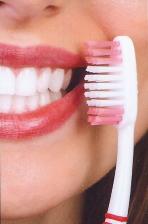
|
A soft brush cleans better because its bristles are more flexible and capable of reaching into the grooves and crevices around teeth and gums. A hard brush might seem to be cleaning better but this is an illusion. When the tongue runs over the teeth the smooth surfaces will certainly feel clean but the tongue will not detect all the plaque that is still lurking in the hollows. Use a soft brush but a strong hand. Brush in three steps:- 1st.� The outer surfaces 2nd. The biting surfaces 3rd.� The inner, tongue-side, surfaces 1.���� Start by closing together on the front teeth. This will relax the lips and the cheeks and actually make more room at the back to move the brush freely. Brush aggressively in large circles and include the edges of the gums. The gums often bleed and become tender when first brushed. This is a sign of gingivitis, caused by plaque and bacteria. Rather than avoid the gums, bleeding is a sign the gums especially need to be brushed. After a few days their condition will improve dramatically. (For more information see the Newsletter No. 31 on Gum Disease.) As well as making the gums healthier, brushing their edges will ensure the teeth are cleaner since most plaque collects around their necks. 2.��� Open slightly and, using a circular motion, brush the biting surfaces. 3.��� Thirdly, clean the inner surfaces, upper and lower.
|
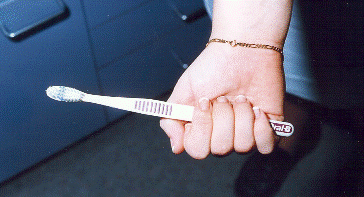
|
The inside of the lower teeth is probably the most difficult to clean properly because the brush has to angle downwards. This is easier if the grip on the brush is changed. Hold the brush across the palm, at a right angle to the forearm, with the thumb on the same side as the fingers. Raise the elbow up to shoulder height and the brush will naturally turn slightly downwards. Again, open only slightly and brush strongly in circles. |
|
HARDENING UP THE TEETH
Most people know that fluoride in the water has hardened up children�s growing teeth. It changes enamel�s weak hydroxyapatite crystals into tough, acid resistant fluoro-apatite and even inhibits the collection of plaque on the enamel surface. People don�t often realize that topical fluoride, applied directly onto the teeth, also prevents decay for adults. It is absorbed especially when it is needed most, when teeth are becoming soft and vulnerable due to acid attack. Most toothpastes contain fluoride and this certainly strengthens enamel, but occasionally something more is needed. For added prevention, buy Colgate Neutraflur 5000 from the chemist. This toothpaste contains 5 times the regular level of fluoride. Think of it as additional protection against decay. Brush with the Neutraflur once or twice a week and then spit out rather than wash out the mouth. The paste will leave a film on the teeth. Areas of weak enamel will soak up the fluoride, together associated minerals such as calcium and phosphate that plaque acids have leached away. Once in a while it will even arrest and repair early superficial decay, without the need for the dentist to drill. Children younger than seven should not use the paste. (See The Flip Side of Fluoride.) Recaldent Tooth Mousse will likewise strengthen enamel. It is basically a milk extract which is supersaturated with minerals such as calcium and phosphate. ( See Tooth Mousse.)
|
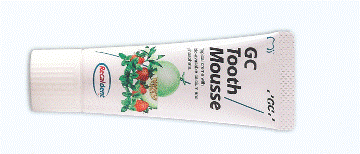
|
A convenient way to apply the mousse is to rub it in with the finger a few times a week. Even if these products are not absolutely needed, they can be a good �insurance policy� against decay. |
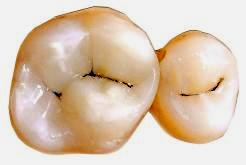
|
A good preventative step is for the dentist to cover the pits with a sealant cement which adheres to the enamel. This keeps the plaque out, smoothes the surface and releases mineral to mature the tooth underneath. See Newsletter No 28 . |
|
Pits are weak and vulnerable. Sealing can prevent decay by keeping out the plaque and rehardening the enamel. |
|
An Interdental Brush, such as a Te Pe Brush, can often be a useful alternative, especially for the back teeth and when the gums have receded. It is used the same way as a tooth pick, being pushed into the space between the teeth near the gums. |
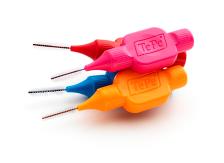
|
Use a different grip for inside of the lower teeth. |
|
PLAQ PRO - THE TOOTHBRUSH THAT SHINES |
|
Young people�s teeth take a while to harden sufficiently enough to resist plaque acids and the risk of decay. The back molars are especially vulnerable because their grooves and wrinkles readily trap food. It is these hollows which are usually the first to get cavities. |
|
CLEANING BETWEEN THE TEETH Dental floss is useful for cleaning between the teeth, even if only used at the front of the mouth. It should be wrapped securely between the two index fingers, gently popped between the teeth and moved slightly into the gum margin and then removed. There is no need to move it back and forward. Cleaning between the back teeth is more difficult. |
|
The big trouble with plaque is that it is tooth coloured and difficult to see. Wouldn�t it be great if you could actually see the plaque and know exactly where to brush? Almost forty years ago my friend Prof. Barrie Gillings had a brilliant idea. He put fluorescein dye into a disclosing solution and painted it onto teeth. When an ultra violet light was shone on the surfaces any plaque fluoresced a bright yellow. Suddenly it was possible to tell precisely where teeth were dirty and where brushing had failed. The Dental Health Foundation embraced the concept and for a number of years even ran its own UV plaque tunnel at the Royal Melbourne Show, showing families how to brush better. PLAQ PRORecently Barrie refined the system by placing a small ultra violet LED light into an electric toothbrush. At the same time I realized the dye could be incorporated into toothpaste. This meant we had a system that could be used conveniently at home, showing people where their brushing had missed and how they could clean better.�
� |

|
Subsequently I approached a small company from Ringwood, Dentalife, and they agreed to manufacture and distribute the product. It was given the name Plaq Pro.���������� ��
|

|
The toothpaste utilizes a more sophisticated thickener than most pastes. It is less course and gritty, so it does not abrade enamel and tooth roots. Unlike some brands, it does not dry out the mouth either. Obviously there is no sugar, but it does contain a higher level of the sweetener Xylitol, which is known to inhibit bacterial growth and, to some extent, harden enamel.
|
HOW TO USE PLAQ PROIt is simple. Clean the teeth as normal with the Plaq Pro toothpaste and rinse out thoroughly. Turn the brush around and press the button. Shine the UV light on the teeth and check in the mirror where plaque shines bright yellow. (I bet there is still a little plaque between the teeth and around the gums.) Repeat the cleaning, this time concentrating on the spots you missed initially. Engage the light and look again, checking especially near the gums. Together with Barrie Gillings I have written an article on the concept for Australasian Dentist magazine. Have a look at A New System For Disclosing Plaq In The Home Setting in the Published Articles section of this website. You can buy a toothpaste/ toothbrush kit at the surgery for about $20. Eventually we hope to distribute the product through pharmacies but initially it is being sold through dental clinics. |


|
Teeth have been brushed but are not really clean. The remaining plaque is difficult to spot. Can you see it? |
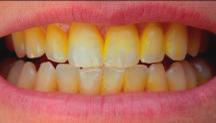
|
Fluorescein will not stain teeth but it certainly stains plaque. Plaq Pro�s UV light shows exactly where plaque remains. |
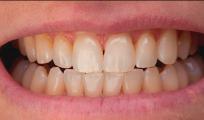
|
When you know exactly where to brush you can remove all the plaque. Now teeth are really clean! |
|
1. |
|
2. |
|
3. |
|
SEALANTS |
|
Plaque glows bright yellow. |

|
This chart is an approximate guide to when children�s teeth come through.
There is immense variation, however, so parents should not worry if baby deciduous teeth seem to be erupting at the wrong time. |

|
CHILDREN�S TEETH |
|
Caring for children�s teeth is all about prevention.
For a good story on the subject see Newsletter No. 29. |
|
Gum line |
|
Six year old molar (permanent tooth). The tooth erupts behind the deciduous teeth. |